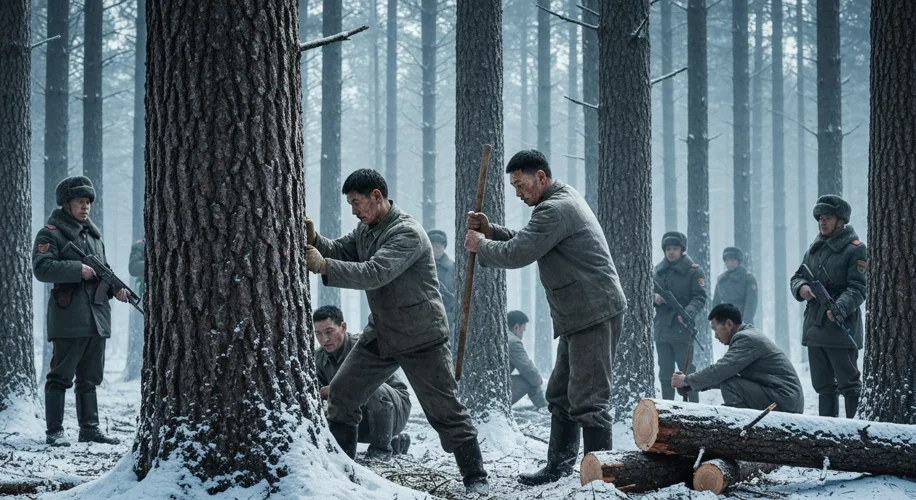The biting Siberian wind whipped across the desolate landscape, a constant, unforgiving companion to the men toiling in the timber camps. Their faces, etched with hardship and hunger, rarely met the eyes of their overseers. These were not ordinary prisoners, nor volunteers seeking a better life. They were North Koreans, men, and increasingly, women, dispatched from their tightly controlled homeland to serve sentences of forced labor in the vast, unforgiving reaches of the Russian Far East and Siberia. This grim chapter, often hidden from international view, echoes with the chilling resonance of historical exploitation, drawing parallels to indentured servitude and penal labor systems that have stained humanity’s past.
Since the late 1960s, and particularly after the collapse of the Soviet Union, North Korea has engaged in a shadowy agreement with Russia. Ostensibly, these agreements facilitated timber extraction and other resource development projects. However, the reality on the ground was far more sinister. Thousands of North Koreans, often young men and women in their prime, were sent to work in logging operations, construction sites, and even mines. Their contracts, if they could be called that, were heavily skewed in favor of the employers. Wages were minimal, often unpaid or siphoned off by intermediaries and the North Korean regime itself. The conditions were brutal: long hours, meager rations, inadequate housing, and a pervasive atmosphere of fear.

The historical parallels are stark. Consider the era of indentured servitude that followed the abolition of slavery in many parts of the world. Individuals, often from impoverished backgrounds or seeking economic opportunity, would sign contracts that bound them to labor for a set period, typically in exchange for passage to a new land. While presented as a voluntary agreement, the terms were frequently exploitative, the work arduous, and the freedom promised often illusory. Similarly, the penal labor systems of Tsarist Russia and later the Soviet Gulag employed millions in forced labor, extracting resources and building infrastructure at an immense human cost. The North Koreans in Russian camps found themselves in a modern iteration of these systems, their labor extracted not by a colonial power or a prison warden in the traditional sense, but by their own government, in complicity with foreign entities.
Key actors in this unfolding drama include the North Korean regime, which viewed these overseas labor programs as a crucial source of foreign currency and a means of managing its population; the Russian companies and regional authorities that profited from the cheap, readily available workforce; and the workers themselves, caught in a system designed to extract their labor with little regard for their well-being or human rights. Reports from defectors and human rights organizations have painted a grim picture: cramped, unsanitary living quarters, limited medical care, and the constant threat of punishment for perceived infractions. Communication with their families back home was severely restricted, further isolating them and reinforcing the control exerted by their handlers.
The specific mechanisms of control were insidious. Workers were often housed in guarded compounds, their movements restricted. They were monitored by North Korean minders who ensured compliance and prevented any dissent. The threat of severe repercussions upon their return to North Korea, including imprisonment or worse for the workers and potentially their families, served as a powerful deterrent against any thought of escape or protest. The lack of transparency surrounding these operations made it exceedingly difficult for international observers to document the abuses or provide assistance. The work itself was often dangerous, with logging accidents and exposure to harsh weather contributing to injuries and fatalities.
The consequences of this exploitation extend far beyond the immediate suffering of the workers. The foreign currency earned through these programs, while ostensibly for the benefit of the North Korean state, has been widely criticized for funding the regime’s illicit activities and its weapons programs, rather than improving the lives of its citizens. Furthermore, the experience of these workers, many of whom eventually return to North Korea, can create a complex psychological burden. They have witnessed a world outside their isolated nation, experienced a degree of freedom, however circumscribed, and endured hardship that few outside their country can comprehend. Their stories, when they emerge, offer a rare glimpse into the realities of North Korean life and the human cost of the regime’s policies.
Analyzing this phenomenon requires an understanding of North Korea’s desperate economic situation and its absolute reliance on external sources of income. For decades, the regime has prioritized military spending and regime survival above the welfare of its people. These overseas labor programs, despite their exploitative nature, represent a pragmatic, albeit morally bankrupt, solution to this perennial problem. The complicity of Russian entities highlights the transnational nature of modern forced labor and the challenges in combating it. It demonstrates how economic incentives can override ethical considerations and international norms.
Ultimately, the story of North Koreans in Russian labor camps is a somber reminder that the ghosts of historical exploitation are not confined to the past. They linger in the shadows of international agreements, in the exploitation of vulnerable populations, and in the persistent pursuit of profit and power at the expense of human dignity. It is a story that demands our attention, our understanding, and our continued efforts to ensure that such unseen workforces are never again allowed to toil in the darkness.

